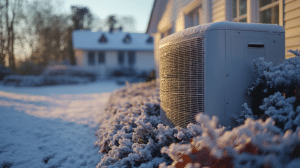
When the chilly months roll in, the last thing you want is for your HVAC system to give out on the coldest day of the year. Preventative maintenance is key to avoiding inconvenient breakdowns and ensuring your home stays warm and comfortable all winter. In this Winter HVAC Survival Guide, we’ll walk you through essential tips for maintaining your heating system during the cold months to keep everything running smoothly.
1. Schedule a Professional Tune-Up
One of the most important steps in your Winter HVAC Survival Guide is scheduling a professional tune-up before the temperatures dip. A certified HVAC technician will inspect your system, clean key components, and ensure everything functions efficiently. A well-maintained heating system is less likely to break down, and the technician can identify any potential issues before they become major problems.
2. Change Your Air Filters Regularly
Air filters play a crucial role in keeping your HVAC system running smoothly. When they become clogged with dust, dirt, and debris, it forces your system to work harder, reducing efficiency and increasing the risk of a breakdown. Make it a habit to change your air filters every one to three months, depending on usage. During the winter, your HVAC system tends to work harder, so more frequent filter changes are a good idea.
3. Check and Seal Your Ductwork
Leaky ducts are a major source of energy loss in homes, especially during the colder months. In this Winter HVAC Survival Guide, we recommend inspecting your ductwork for any visible signs of damage or leaks. If your ducts are in the attic or crawlspace, having a professional inspect them for hidden leaks is worth it. Sealing these leaks will improve your system’s efficiency and reduce heating costs.
4. Keep Vents and Registers Unobstructed
It’s easy to overlook the importance of vent and register placement during the winter, but ensuring they are clear and unobstructed is essential for maintaining efficient airflow. Furniture, rugs, or drapes can block vents, preventing warm air from circulating properly throughout your home. In this Winter HVAC Survival Guide, we suggest making sure all vents are open and unobstructed, especially in rooms you use most frequently.
5. Inspect Your Thermostat
The thermostat is the brain of your HVAC system, and any malfunction could result in temperature fluctuations or energy waste. During the winter, a malfunctioning thermostat can make it difficult to maintain a comfortable temperature. Check your thermostat settings regularly, and if you notice any inconsistencies in temperature, consider replacing the batteries or upgrading to a programmable thermostat for better control over your heating schedule.
6. Keep the Area Around Your Furnace Clean
Your furnace works hard to keep your home warm during the winter, so keeping the area around it clean is essential. This includes removing dust, debris, or combustible materials that could obstruct airflow or pose a fire hazard. This Winter HVAC Survival Guide emphasizes the importance of keeping a safe, clean environment around your furnace to help it run efficiently.
7. Consider Upgrading Your System
If your HVAC system is over 10–15 years old, consider upgrading to a newer, more efficient model. Advances in HVAC technology have made modern systems more energy-efficient and environmentally friendly, saving you money in the long run. While this may not be a short-term fix, it’s an essential consideration in any Winter HVAC Survival Guide for homeowners looking to avoid frequent repairs and improve energy savings.
8. Ensure Proper Insulation
Good insulation is crucial for keeping your home warm in the winter. Without proper insulation in your walls, attic, and floors, your HVAC system must work overtime to maintain a comfortable temperature. In this Winter HVAC Survival Guide, we recommend checking your insulation and considering upgrades if necessary. This will help prevent heat loss and reduce strain on your heating system.
9. Test the System Before Cold Weather Hits
Don’t wait for the first snow to turn on your heating system. The Winter HVAC Survival Guide recommends testing your HVAC system before cold weather arrives. Turn the heat on for a few minutes to ensure it works properly and the airflow is strong. If you notice any unusual sounds, smells, or poor heating performance, now is the time to call a professional.
10. Monitor and Adjust Humidity Levels
Low humidity is a common problem during winter, and it can make your home feel colder than it is. A furnace can dry out the air, leading to dry skin, static electricity, and discomfort. Consider using a humidifier to maintain optimal humidity levels in your home. Maintaining a healthy humidity level improves comfort and reduces the stress on your HVAC system, making it an important tip in our Winter HVAC Survival Guide.
Final Thoughts
Winter can be tough on your HVAC system, but with proper care and maintenance, you can ensure your home stays warm and comfortable all season. By following the tips in this Winter HVAC Survival Guide, you’ll be able to avoid unexpected breakdowns, increase energy efficiency, and extend the lifespan of your system.
If you need assistance with maintenance, repairs, or upgrading your system this winter, don’t hesitate to contact Sun Air Conditioning. Their team of experts can provide the professional service you need to keep your HVAC system running smoothly throughout the colder months.
Stay warm and keep your HVAC system in top shape this winter!
 Rated 5.0 out of 5.0
Rated 5.0 out of 5.0


